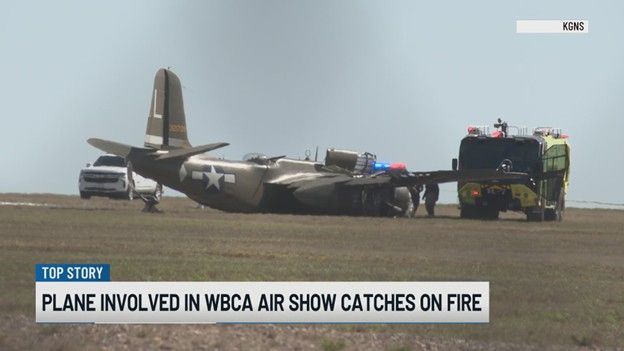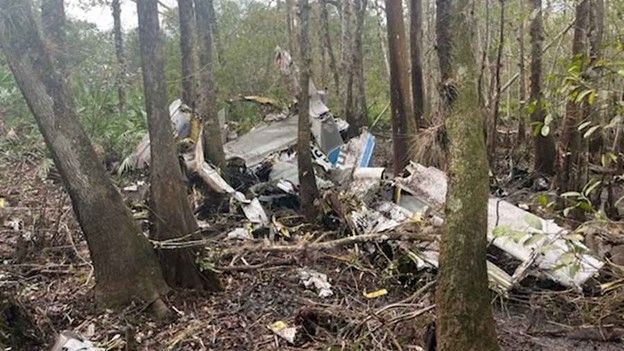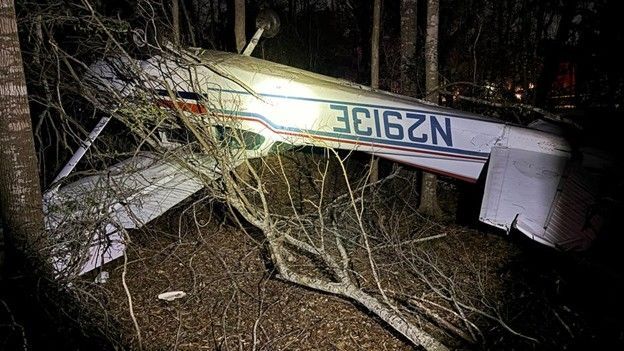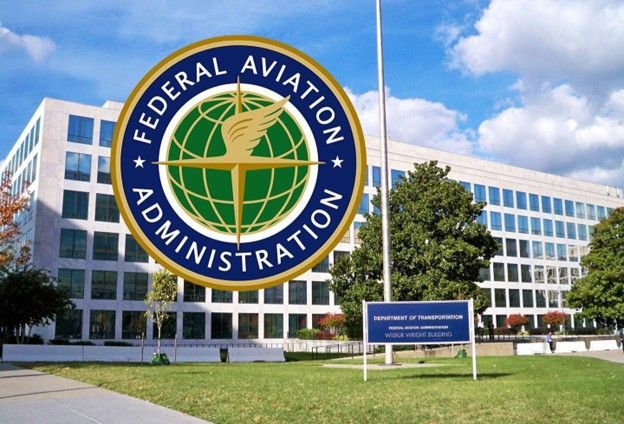ARFF Daily News
Published on:
Monday the 17th of February, 2025
WBCA Air Show planned to resume after plane catches fire Sunday afternoon
One person taken to hospital in critical condition
By KGNS Staff
LAREDO, Tex. (KGNS) - The WBCA Stars & Stripes Air Show Spectacular was put on pause after a plane involved in the show caught fire shortly before 1:00 pm Sunday afternoon.
KGNS was told that it was announced at the show that the engine caught fire while in the air. The pilot landed the plane and the fire was put out while on the ground.
Preliminary reports from the Laredo Fire Department said a man in his 70s was taken to Laredo Medical Center in critical condition. He was then taken to San Antonio for observation. The Laredo Police Department has confirmed only one plane was involved. It is unknown if there were other people inside the aircraft.
A KGNS crew on scene reported the fire was put out.
No other injuries were reported at this time.
The Federal Aviation Administration is taking over the investigation.
LPD closed of Bartlett and Jacaman Road shortly after the incident occurred.
Despite this incident the airshow resumed at 1:30 p.m.
The Stars and Stripes Air Show is a popular attraction of the Washington’s Birthday Celebration that draws heavy crowds from Laredo, as well as people from across the State of Texas, and the country as well.
The Laredo Police and the Federal Aviation Agency is asking for the community’s assistance with anyone who may have captured the airplane incident at the airshow. Anyone who has any video can scan a provided QR code and dropping the video there. The footage will assist with the investigation into the aircraft accident today.

Pilot confirmed dead in plane crash in Flagler County, officials say
Wreckage found near Volusia County line after plane loses contact with airport
Brandon Hogan, Digital Editor - Jacob Langston, Digital Journalist
FLAGLER COUNTY, Fla. – The pilot’s body was located on Saturday after an aircraft went down overnight in a rural area in Flagler County, according to the National Transportation Safety Board.
Officials said the aircraft lost contact that evening with the Palatka Municipal Airport, the sheriff’s office said on social media, adding the search drew a large law enforcement presence to the area of State Road 11 near the Volusia County line in Bunnell.
In a post Saturday morning, the sheriff’s office said the aircraft had been located in a densely-wooded area of Flagler County.
The NTSB said in an update on Saturday evening that prior to the crash, the plane took a right turn and “disappeared from the radar.”
An extensive search with assistance from the Volusia County Sheriff’s Office’s helicopter led to the aircraft’s discovery near the county line, another post states. A photo shared with the post contains a caption describing the location of wreckage in deputies’ search for the missing plane.
Flagler County Sheriff Rick Staly later specified the aircraft is a 2012 Cessna 208 that was planned to be used in the upcoming week for skydiving.
Rook Nelson is the president of Illinois-based Eagle Air Transport Inc., which he confirmed owns the aircraft. Nelson provided the following statement to News 6:
“We became aware around 8 pm last night that there was an incident involving one of our aircraft. Around 6 pm an experienced pilot departed Sebastian, FL enroute to Palatka. The aircraft did not make it to its destination for unknown reasons. We have very little information beyond this and are working with local and federal authorities in the ongoing investigation.”
Rook Nelson, president of Eagle Air Transport Inc.
Staly held a news conference before noon Saturday near the site of the crash, describing the situation as a “recovery mission.”
“They lost contact with the aircraft about 7:30 p.m. We were notified at 8 p.m.,” Staly said. “ (...) Just a little after midnight, we located the aircraft. It was pitch dark last night, there was no moon, a lot of cloud coverage. I was here last night, it was about the worst conditions you can imagine to try to find an aircraft, and how we found it based on the general area of the aircraft — what Jacksonville authorities indicated on their radar — was, we started walking in, actually, this area, and noticed the smell of fuel. That allowed us to have the Volusia helicopter pointed in a smaller area and they spotted one of the tires.”
The pilot had not yet been identified and their next of kin had not been notified at the time of this report, Staly said. In a statement, the sheriff’s office told News 6 that the pilot is believed to be male.
“After it dropped off the radar, the air traffic controllers did try to raise the aircraft. There was no contact. We had been given a phone number for who we believe was the pilot and had no contact there either, and so we extend our condolences to the loved ones and the family,” Staly said.
An FAA spokesman provided the following statement to News 6, clarifying the information was preliminary and subject to change:
A Cessna 208 crashed in a field in southern Flagler County, Florida, around 1:00 a.m. local time on Saturday, February 15. Only the pilot was on board. The FAA and the National Transportation Safety Board (NTSB) will investigate. The NTSB will be in charge of the investigation and will provide any updates.
Kevin Morris - FAA Office of Communications
The NTSB said the wreckage was spread out over 100 yards and they hope to be able to remove the wreckage on Sunday, but the area is swampy and remote.
Anyone who has any information about the situation is asked to contact the sheriff’s office at 386-313-4911.
https://www.clickorlando.com/news/local/2025/02/15/deputies-search-for-aircraft-that-possibly-went-down-in-flagler-county-sheriffs-office-says/

Small plane crashes near Pearland Regional Airport, no injuries reported
PEARLAND, Texas - A small plane crashed in Pearland late Sunday night and will be investigated by the Federal Aviation Administration.
The pilot was the only occupant on the plane and had no visible injuries when authorities arrived at the scene.
What we know:
The plane crashed in the woods between Dixie Farm Road and County Road 127 near the Pearland Regional Airport around 10:45 p.m.
Texas Department ofd Public Safety troopers arrived at the scene and found the male pilot on the side of the road with no visible injuries.
The plane was upside down in the woods a couple of hundred feet away from the roadway. There was no damage to property or injuries reported.
DPS took over the scene from Pearland police and the FAA will handle the investigation.
What we don't know:
The cause of the crash is unknown at this time.
https://www.fox26houston.com/news/small-plane-crash-near-pearland-regional-airport

Layoffs Hit FAA
Layoffs may have inadvertently hit high-ranking employees.
Russ Niles
The FAA was caught in the latest round of mass layoffs by the Trump administration, including a technician who was working on the investigation of the Washington midair collision. Jason King told Washington television station WUSA that a list of 500 FAA employees potentially targeted for layoff was circulating on his last day at the agency, some of them directly involved with flight safety. “Aviation safety should never be treated as a budget item that can just be completely cut,” he said. “Weakening the FAA’s safety efforts threatens public trust and increases the likelihood of future accidents.” Many essential FAA workers, like controllers, are exempt from layoff.
King, who started at the FAA eight months ago, said the list apparently targeted probationary workers with less than a year's service. There are now reports circulating that the net might have been cast a little wider than that. Apparently recently promoted employees become designated as probationary so they can be reassigned to their former jobs if the new gig doesn't work out. That means some of the layoffs hit veteran employees with years or decades of experience who were in high-ranking positions. We've asked the FAA for confirmation of this but haven't heard back.

NTSB Final Report: Maule MXT-7-180
Airplane Overshot The Runway, Banked Steeply, Stalled, And Entered A 1/2 Turn Spin Before Impacting The Ground
Location: La Porte, Texas Accident Number: CEN23FA164
Date & Time: April 24, 2023, 08:46 Local Registration: N4008J
Aircraft: Maule MXT-7-180 Aircraft Damage: Substantial
Defining Event: Loss of control in flight Injuries: 1 Serious
Flight Conducted Under: Part 91: General aviation - Other work use
Analysis: Just after departing from runway 5 on an aerial survey flight, the pilot announced on the airport’s common traffic advisory frequency that the engine was running rough and he was returning to the airport. Another pilot flying in the airport traffic pattern reported that the accident airplane appeared too high and fast to land on runway 23; shortly thereafter, the accident pilot transmitted that the engine was producing power and that he was landing on runway 5. The witness saw the accident airplane subsequently enter a left base for runway 5 at low altitude and stated that the airplane appeared slow. The airplane overshot the runway, banked steeply, stalled, and entered a 1/2 turn spin before impacting the ground. Two other pilots who were flying in the area reported similar observations of the accident sequence, and ADS-B track data was consistent with their statements.
The airplane impacted the ground and ground scars were consistent with a nose-low, right wing down attitude. The fuselage and both wings sustained substantial damage. Examinations of the airframe, engine, and fuel system did not reveal any pre-impact anomalies that would have precluded normal operations. The weather conditions at the time of the accident were conducive to the development of serious carburetor icing, which was consistent with the pilot’s announcement of a rough running engine. The circumstances of the accident are consistent with the pilot’s exceedance of the airplane’s critical angle of attack while maneuvering for an emergency landing following a partial loss of engine power, which resulted in an aerodynamic stall/spin and impact with terrain.
Probable Cause and Findings: The National Transportation Safety Board determines the probable cause(s) of this accident to be -- The pilot’s exceedance of the airplane’s critical angle of attack while maneuvering for an emergency landing following a partial loss of engine power, which resulted in an aerodynamic stall/spin and impact with terrain. Contributing to the accident was the partial loss of engine power due to carburetor icing.
FMI: www.ntsb.gov
NTSB Final Report: Piper PA46
Spatial Disorientation During A Missed Approach In Instrument Meteorological Conditions
Location: Yoakum, Texas Accident Number: CEN23FA084
Date & Time: January 17, 2023, 10:36 Local Registration: N963MA
Aircraft: Piper PA46 Aircraft Damage: Substantial
Defining Event: Loss of control in flight Injuries: 4 Fatal, 1 Serious
Flight Conducted Under: Part 91: General aviation - Business
Analysis: A review of air traffic control (ATC) data showed that the airplane departed with an instrument flight rules (IFR) clearance for the destination airport. The pilot requested and was cleared for an RNAV (GPS) approach into the destination airport. When the airplane was descending through 3,500 ft msl , the controller instructed the pilot to report cancelling the IFR clearance and approved a radio frequency change. There was no further communication from the pilot; the ATC facility reported that radar contact was lost when the airplane reached 2,000 ft msl, which was normal for the approach.
The sole surviving passenger reported the airplane was off course during the approach, and the pilot was struggling with the airplane to get it back on course. The passenger remembered hearing a warning alarm several times and the airplane “aggressively pitching up” with more warning alarms and then “aggressively pitching down.” He observed the pilot pulling hard on the yoke and he believed he heard the copilot calling for the pilot to try and get the nose of the airplane up and straightened out. He said that he couldn’t see anything out of the windows due to the clouds and fog until right before the airplane impacted the ground. The airplane came to rest in an open pasture about 1.5 miles from the destination airport.
Low IFR (LIFR) conditions were forecast for the area of the accident site and the destination airport. The National Weather Service (NWS) forecasts were consistent with the weather conditions encountered by the pilot on the approach.
Data recovered from the airplane’s autopilot indicate that the pilot began the approach with the autopilot engaged. When the airplane was about 1 mile from the runway and 500 ft above the airport elevation, the pilot initiated a right climbing turn and disconnected the autopilot. This action was consistent with the initiation of the missed approach procedure. Autopilot data indicate that the airplane’s pitch then increased as high as +20° and roll to +47° (right) during the climbing right turn. These angles suggest that the pilot likely had difficulty controlling the airplane. The pilot then engaged the autopilot’s unusual attitude recovery mode. The autopilot made inputs to return to a level flight attitude; however, autopilot data indicate that the pilot made conflicting flight control inputs. As a result, the airplane entered a brief descent, followed by a rapid climb. Indicated airspeed at the top of the climb was 16 knots, well below the airplane’s stall speed for any flap configuration. Thus, the airplane likely entered an aerodynamic stall followed by a rapid descent to impact with the terrain. The airplane impacted an open field at a shallow pitch angle, which suggests that the pilot may have attempted a stall recovery maneuver. However, altitude was insufficient for a full recovery.
Postaccident examination revealed no anomalies with the airframe, engine, or autopilot. Toxicology testing showed trace levels of pheniramine, naltrexone, naltrexol, and CBD in the pilot’s system. Although postmortem toxicological testing indicates that the pilot had used these substances, his performance was not likely impaired by effects of those substances at the time of the accident.
Based on the level of meclizine detected in the copilot’s heart blood, it is reasonably likely he was experiencing some effects of this medication at the time of the accident. However, whether such effects impaired his performance in a way that contributed to the accident is unknown, particularly considering his uncertain role on the flight and the presence of the other pilot. The copilot’s toxicology testing also indicated he had used cetirizine, but this medication was not detected in his blood, so it was not likely causing impairing effects at the time of the accident.
The pilot’s difficulty in controlling the airplane when initiating the climbing turn in instrument conditions, along with the activation of the autopilot’s unusual attitude recovery mode, and his continued inappropriate control inputs suggest that pilot was experiencing spatial disorientation during the missed approach procedure.
Probable Cause and Findings: The National Transportation Safety Board determines the probable cause(s) of this accident to be -- The pilot’s spatial disorientation during a missed approach in instrument meteorological conditions, which led to an exceedance of the airplane’s critical angle of attack and a subsequent aerodynamic stall.
FMI: www.ntsb.gov
NTSB Final Report: Junior Ace
Pilot’s Intentional Flight Into Terrain As An Act Of Suicide
Location: Mammoth Springs, Arkansas Accident Number: CEN23FA155
Date & Time: April 13, 2023, 13:30 Local Registration: N5545
Aircraft: Junior Ace Aircraft Damage: Substantial
Defining Event: Low altitude operation/event Injuries: 1 Fatal
Flight Conducted Under: Part 91: General aviation - Personal
Analysis: The airplane, which was owned by the pilot, took off from a private airstrip and flew to a rock quarry. Witnesses saw the airplane circle around the quarry several times. One witness saw the airplane fly directly into the quarry and collide with a rock wall. The wreckage was located directly below and adjacent to a 75-ft rock wall. The damage to the wreckage was consistent with a high-energy impact. Examination of the airplane revealed no preimpact mechanical deficiencies that would have precluded normal operation.
Postmortem toxicological testing detected ethanol at 0.048 g/dl, along with n-propanol, in the blood cavity. Neither ethanol nor n-propanol was detected in vitreous fluid. Detection of npropanol in a postmortem specimen is potentially indicative of postmortem microbial activity in the specimen but does not necessarily mean that microbial activity produced ethanol. These findings suggest that the ethanol detected was likely from postmortem production, not alcohol consumption.
Following a death investigation, local law enforcement and the local the coroner classified the manner of death as a suicide.
Probable Cause and Findings: The National Transportation Safety Board determines the probable cause(s) of this accident to be -- The pilot’s intentional flight into terrain as an act of suicide.
FMI: www.ntsb.gov

Today in History
66 Years ago today: On 17 February 1959 A THY Vickers Viscount crashed while on approach to London Airport, United Kingdom , killing 14 occupants; 10 survived the accident.
Date: Tuesday 17 February 1959
Time: 16:47
Type: Vickers 794D Viscount
Owner/operator: Türk Hava Yollari - THY
Registration: TC-SEV
MSN: 429
Year of manufacture: 1958
Total airframe hrs: 548 hours
Engine model: Rolls-Royce Dart 510
Fatalities: Fatalities: 14 / Occupants: 24
Other fatalities: 0
Aircraft damage: Destroyed, written off
Category: Accident
Location: 5,2 km W of London-Gatwick Airport (LGW) - United Kingdom
Phase: Approach
Nature: Passenger - Non-Scheduled/charter/Air Taxi
Departure airport: Roma-Ciampino Airport (CIA/LIRA)
Destination airport: London Airport (LHR/EGLL)
Confidence Rating: Accident investigation report completed and information captured
Narrative:
A THY Vickers Viscount crashed while on approach to London Airport, United Kingdom , killing 14 occupants; 10 survived the accident.
The aircraft was on a special flight from Ankara to London via Rome with Adnan Menderes the Prime Minister of Turkey and a party of Turkish Government officials on board. The aircraft left Rome at 13:02. TC-SEV called London Airways at 15:56 after passing Abbeville and was cleared by ATC to the Epsom Radio Range station, the holding point for London Airport. Because of poor visibility at destination London (Heathrow) Airport, the London Airport Commandant decided to inform the Turkish captain that he should divert to Gatwick. At 16:21 hrs the aircraft reported over the Epsom range and was given diversion instructions. At 16:27 it left Epsom for Mayfield, the holding point for Gatwick, where it was informed by Gatwick Approach Control that it would be positioned by radar for an ILS approach to runway 09. The latest weather report for Gatwick was given as wind calm, visibility 1.1 nm, mist, cloud 3 oktas at 600 feet, QFE 1036 mb. Over the Mayfield NDB at 4,000 feet the flight was instructed to steer a course of 280 and to descend to 2,000 feet. This was acknowledged. A further descent clearance was given to 1500 feet. The aircraft overshot the centre line slightly as it turned on to the ILS approach path. At 5nm from touchdown, the aircraft affirmed that it could continue on the ILS. TC-SEV was then asked to change to tower frequency and this request was acknowledged. This was the last communication with the aircraft. At a position of some 5 km from the runway threshold and 550 feet to the north of the approach path centre line, the aircraft contacted tops of trees 390 feet amsl at the edge of Jordan's Wood. The aircraft began to disintegrate as it descended through the trees at an angle of about 6 degrees from the horizontal until the wheels made contact with the ground. After rising again slightly the main part of the wreckage came to rest about 100 yards further on and then caught fire.
PROBABLE CAUSE: "The evidence is insufficient to establish the cause of the accident. There is no indication however that this can be associated either with a technical failure of the aircraft or with a failure of the ground services."

